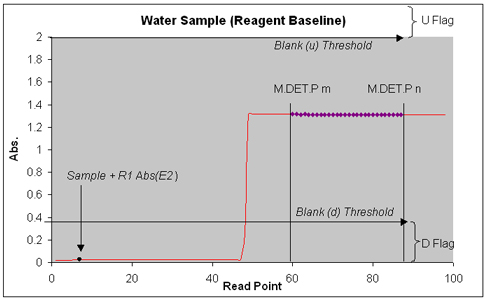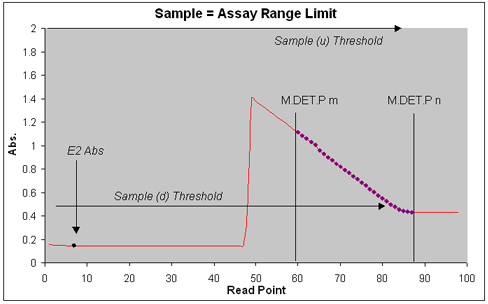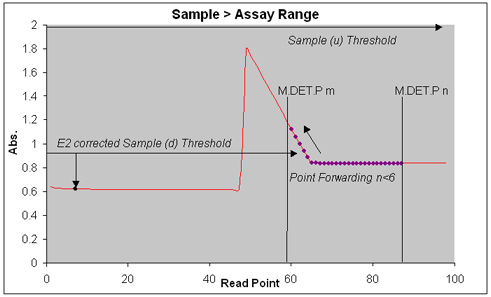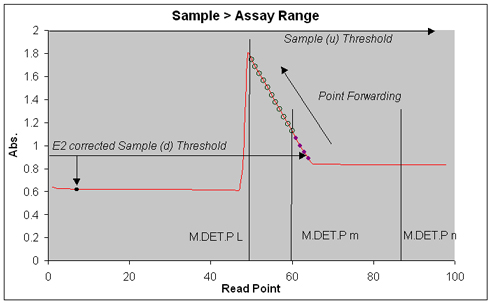
The chemistry system monitors the absorbance change of rate reactions (RRA) during a read window determined by main detection points (M.DET.P) m and n. Ninety-eight detection points are available for all 10-minute reactions. For those reactions using a second reagent (R2) as a trigger or starter reagent, the read window is available between cycles 48 and 98.
The detection points between M.DET.P m and n determine the number of detection points used for measurement.
The following checks ensure that the absorbance readings used in the calculation of a result for an enzymatic rate method are precise and accurate.
The absorbances collected between M.DET.P m and M.DET.P n are subjected to linear regression analysis to determine the slope (delta absorbance/minute). The factor parameter value is the allowable standard deviation of any absorbance point from the fitted regression line. A point exceeding this factor is eliminated from the regression analysis.
The cycle parameter value determines the number of times the data points are subjected to the factor check. Valid absorbance points are calculated in this manner and the number of absorbance points used during the rate calculation is shown on the printout of results. The minimum number of points required for a valid calculation is 6.
Any result calculated with less than 6points prints a lowercase n. This flag is indicative of an imprecise reaction and/or high activity. For a detailed description, please refer to Sample (u) and Sample (d) Settings.
These checks are applied to reagent blank samples. Blank (u) is the highest absorbance and Blank (d) is the lowest absorbance allowed for any absorbance point monitored over the M.DET.P m and M.DET.P n read window.
These checks are only applied to main wavelength data. Using typical reagent blank absorbance values at the main wavelength, the general recommendations for these 2 parameter values are listed below.
|
Decreasing Rate Reactions: |
Blank (u): 2.0 A. Blank (d): 50% of the lowest absorbance obtained within the read window for the reagent blank |
|
Increasing Rate Reactions: |
Blank (u): 150% of the highest absorbance obtained within the read window for the reagent blank Blank (d): 50% of the lowest absorbance obtained within the read window for the reagent blank |
The purpose of these checks is to ensure reagent integrity before the sample analysis is performed. If these checks are exceeded, an uppercase U or D prints on the report.

Sample (u) and Sample (d) are the maximum allowable absorbance limits used to ensure a linear reaction rate analysis.
The Sample (u) threshold is a high absorbance value applied to increasing absorbance change methods. The Sample (d) threshold is a low absorbance value applied to decreasing absorbance change methods.
E2 correction allows the system to adjust these thresholds based on the absorbance contribution from a sample. E2 correction is calculated from the main wavelength absorbance monitored at detection point 7.
The setting of the M.DET.P L at a detection point before M.DET.P m allows the system to compensate for high sample activities and perform the process of point-forwarding. By including these additional detection points, from M.DET.P L to M.DET.P m, absorbance values from earlier in the reaction can be used in the calculation of the result.
The process of point-forwarding is initiated only for samples that exhibit E2 Corrected main wavelength absorbances greater than Sample (u) for an increasing absorbance reaction or less than the Sample (d) for a decreasing absorbance reaction.
In these cases, each absorbance that exceeds the threshold is eliminated from the rate calculation. If the number of absorbance points is reduced to less than 6, the absorbances from the detection points between M.DET.P L and M.DET.P m are included in the rate calculation. This process ensures that results are not reported from data generated by samples showing nonlinear reactions due to high activity. High activity samples that are not calculated by point-forwarding are not reported and a lowercase u or d prints on the report.
In some cases high results calculated by the point-forwarding process may print with a lowercase n. This indicates that initially, 6 or more valid absorbance points were generated as judged by Sample (u) and Sample (d) thresholds, but eliminated by the factor check. In this situation assess the validity of the result respect to the result and the desired accuracy at this extremely elevated value.

The establishment of the Sample (u) and Sample (d) absorbance thresholds is assay-dependent, requiring the collection of main wavelength absorbance data for a sample that is of a high enough activity to demonstrate nonlinearity during detection points 2 – 46 for 1-reagent assays and points 49 – 98 for 2-reagent assays.
Main wavelength absorbance points are depicted by the red line in graphs in the Reaction Monitor window. It is recommended to select an absorbance value that has at least 2 detection points before nonlinearity occurs. The main wavelength E2 absorbance value for the sample is required to adjust the selected absorbance after nonreactive sample contribution. The correction is shown in the following equation:
Sample (u) or Sample (d) Setting = Selected Absorbance Value - (E2 Abs. x k), where
· E2 Absorbance = E2 Abs. of sample - E2 Abs. of reagent blank
·· k = Fluid volume correction (for two-reagent assays only)
The fluid volume correction formula used in the equation is:
Sample volume + R1 volume/(Sample volume + R1 volume + R2 volume)
Make the choice of M.DET.P L used for point-forwarding by viewing the absorbance data displayed at the Reaction Monitor window. Select a read point that is not affected by early or lag reaction nonlinearity.
In the case of reagents that show degradation over time, establish the Sample (u) and Sample (d) thresholds using reagents at the end of their on-system (or reconstituted) life.

Sample requiring point-forwarding

Sample with point-forwarding applied
This parameter is used to detect adverse changes that may occur when sample and R1 reagent are incubated or when instantaneous changes occur when R2 is added to sample and R1.
The Check DP1 is generally made at detection point 46 or 49. The process utilizes the Sample (u) or Sample (d) thresholds. The main wavelength absorbance at Check DP1 is compared to the Sample (u) or Sample (d) value following fluid volume correction.
Any analysis that exceeds these thresholds is flagged with an uppercase U or D on the printout.